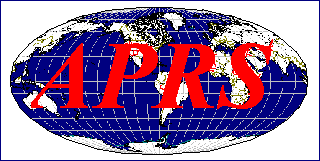APRS 1.2 SPEC ADDENDUM PROPOSALS: The APRS protocol was well defined by the 1996 time frame
in the original APRSdos docs.
But it was then formalized in the APRS1.01
publication in 2000. The first
APRS 1.1 ADDENDUM
was completed and approved in July 2004. . This APRS1.2 addendum contains all the spec updates since then. .
For a comparison of what has been implemented in what clients, please see the
Capabilities Chart.
But first we will list as a reminder all of those items that have already been
included in 1.1:
Already in APRS1.1:
A baseline of APRS usage as defined through July 2004.
Up-to-date SYMBOL tables, symbol attributes, and criteria for Just-mobiles and Just-WX
Up-to-date TO-CALLS, Version ID's and Experimental Formats
DIGI standards for Overlay Characters, Default Paths, the use of NOID and HID and SSID's
Notes on DATUMs, map Range Scales, and PHG display, and packet time stamps
Message details on the Reply-ACK Algorithm, and Polygon and Line OBJECTS
notes on OBJECTS including punctuation, ownership, killing and equality with stations
Formats no longer recommended: Compressed-Objects, ITEM Format, Raw Weather Formats,
A link to the WXSVR Protocols and some small details on the APRS-Internet system
New-N Paradigm: . There were also some recommendations for the good of the APRS
national channel with
respect to Digipeater ID rates, HF freqs and TNC offsets, Voice-Alert, and Recommended
DIGI paths and settings. . These improvements were noted collectively as the
New-N Paradigm and were adopted in the USA beginning
in about 2004 and in Europe on 20 Nov 2008. The New-N Paradigm has made dramatic improvements
throughout the APRS network.
SPEC 1.2 ISSUES: This web page documents the ideas that have been proposed
for further discussion and eventual addoption as APRS SPEC Addendum 1.2:
SPEC ADDITIONS:
Proposal (28 Apr 2020): Allowing 000-999 in addition to the original 000-255 telemetry fields in the
five channel T#sss,111,222,333,444,555... format.
Extension of top speeds above Mach 1. For any speed S above 670 kts, display speed as S*112 - 74370 Knots. IE Space Station encoded as 799 decodes to 15,118 kts (This is a correction from earlier S*135-9000).
Use of the RR-bits for the
Precedence-bit and the
Operator-bit.(Dec 2012)
Preemptive Digipeating for gateways and more efficient events or travels (Dec 2012)
PHG in Mic-E format. The Mic-E text field can contain any normal Position comment field too. Such as PHG. (important for Mic-E hardware digipeaters).
Original Mic-E Telemetry Format is depricated. Overtaken by
MFR TYPE codes. A new Telemetry format has
been developed See spec
.
High precision !DAO! & datum option
with precision to 1 ft with included datum.
Adding Frequency to packets Lets you find someone in the Freq domain!
APRS Touchtone formats for using DTMF radios for simple APRS functions
MESSAGE PROPOSALS:
OPERATING IMPROVEMENTS:
SYMBOLS & OBJECTS: Although Symbols are maintained under the APRS11 addendum, here are the
links to those pages.
UPDATES:
WEATHER:
NEW IDEAS:
- IS-to-RF Gating (rev-b) of local IS mobiles to local RF.
(obsolete rev-a).
- Microwave Experiment Antenna Pointing using APRS
- Bar-Code Formats for APRS
- SkyCommand additions to APRS
- Emergency Codes for non-Mic-E systems
- Displaying a Circle or other attribute around any IGate station that sends an IGATE Status packet. (independent of symbol)
- New Digipeater Object Caching concept. (optional)
- Manual Table Position reporting with the TH-D7 (without a GPS).(Optional)
- Omni-DF-ing techniques needing no DF equipment or antenna.
- Probes (PHGR) concept addition to PHG for realtime
measuring of Network Reliability.
- MileMarks for interstate reporting.
Description,
Basic code, and
mm-data.dat file.
- SMART DIGI concepts.
- Japanese APRS:
APRS JGates for linking the Japanese NAVITRA system with APRS .
- ECHOlink & IRLP node status on APRS
- The EYEBALL ICON if it has a RNGXXX descriptor will cause everyone's
map (if the feature is enabled) to CENTER and ZOOM to range RNGxxxx
on first receipt.
APRS SPEC 1.3 proposals:
- New APRS Areas
evolving in HAM radio that involve APRS.
WORK IN PROGRESS:
Some additional notes were received from reviewers that have not yet
been fully incorporated into either 1.1, 1.2 or 1.3 addendums. These
are listed as submitted:
- Formula for sizing is not specified in spec.
- Colors of circles are not specified.
- DFSxxxx has slash after it? Not specified in spec.
- DFSxxxx/ has speed/course after it? Not that way in the spec.
- Where the spec describes objects/items, it doesn't allow for /BRG/NRQ.
Refer to page 97. In other places where it talks about
/BRG/NRQ it specifically shows them as a possible option in the format.
- The spec shows that DFS and /BRG/NRQ can exist in the same packets,
which is most likely wrong. The spec should be revised.
- In the spec it shows that you can have DFS or Course/Speed, but not both
at the same time. In your example packets (from DOSaprs) you have both, with
DFS coming first. Which one is correct? One or the other should be revised so
that they agree.
- For a zero (0) signal level, avoid the divide-by-zero error by
changing the 0 level signal to 0.8. This is not in spec or on Bob's web pages.
OMNI-DF: To see what the OMNI-DF screen (based inversly on PHG)looks like,
see: Bob's DFing WEB page
Back To the APRS site-map
Back To the MAIN APRS page
